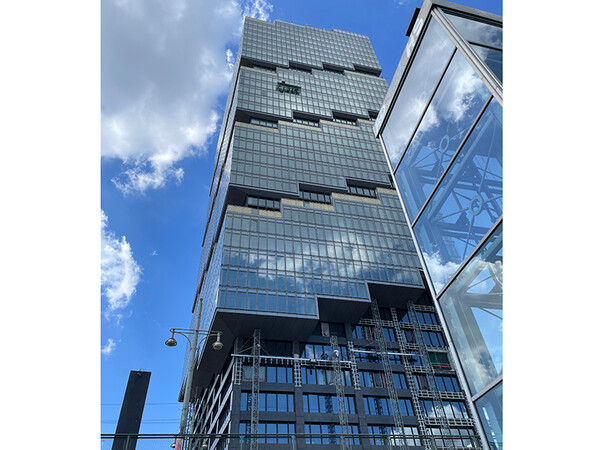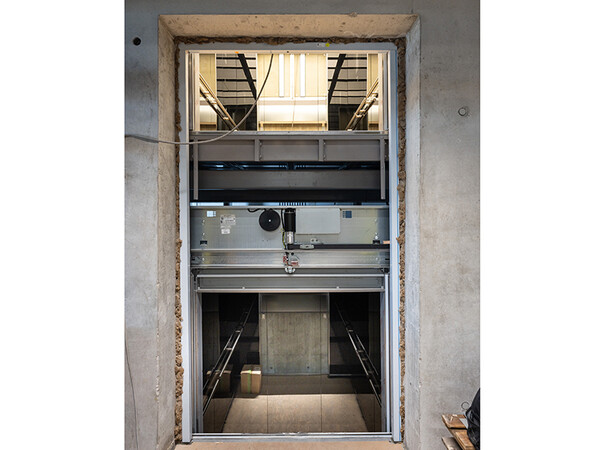Up and away with the Kone double decker
When you read this LIFTjournal, it will be almost complete: the “East Side Berlin”, currently the highest building in the German capital. But it is not just its height and extraordinary architecture that make it remarkable: ...
It is also the first high-rise building in the German-speaking countries where Kone’s double decker lifts are being installed. They will have been completed by the end of the year.
By Ulrike Lotze
Admittedly, the double decker principle is not quite new and not a unique Kone product either; for example, there was the Twin of TK Elevator twenty years ago. To be precise, these lifts have actually been in use for over 130 years. Some of the oldest and most famous double decker lifts operate in the corner columns of the Eiffel Tower.
More information: The following lifts are installed in the Edge (download as PDF) What these special high-performance lifts have in common is a great advantage: thanks to the two cars in one shaft, they have a high conveyance capacity and can transport twice as many users as classic lifts. A "double decker" always stops at two storeys above each other, where the passengers can get in and out. This not only accelerates transport in busy high-rise buildings but also saves valuable building space for the lift shaft, which is greatly appreciated by building owners and architects.
The eight double decker lifts installed in the building core of the EDGE would actually need 16 shafts. The owner can lucratively lease the space saved. Incidentally, the Kone double deckers have already been installed in other countries – for example, in Moscow and London, where the property prices are so high that every lettable square metre saved is money in the bank.
Even faster is possible …
 Not only the height, but also the extraordinary architecture make the Edge East Side Berlin something special. Photo: © Ulrike Lotze
Not only the height, but also the extraordinary architecture make the Edge East Side Berlin something special. Photo: © Ulrike LotzeThe high conveyance capacity in the Edge is an important argument: the main tenant of the 140 m high building is Amazon, which has concentrated all of its Berlin branches and employees here. The users are transported at 6 m/s (21.6 km/h) - the maximum travel time from the ground floor to the roof terrace on the 35th floor is all of 20.6 seconds. Going even faster would be possible but experiments have demonstrated that this then becomes unpleasant for users.
Why did it take so long until Kone installed the double decker lifts in Germany? "Lifts here usually aren’t subject to such heavy use as in other parts of the world," explained Kone Site Manager Holger Weigand. "I can still handle 1,600 to 1,800 passengers with a group of ten." In this specific case, the building was actually designed for up to 3,500 people. There is room enough for this: the skyscraper contains 80,000 m2 of which 65,000 can be leased.
German premiere for the Maxi drive
 Two cars in one shaft ... Photo: © Kone
Two cars in one shaft ... Photo: © KoneAnd there are yet more special features: the lift group has installed its most powerful drive, the MX 100, in the Edge – this too is a premiere in Germany. With its 134 kW output, it can move up to 52 passengers in the two cars (four ton payload). The frequency converters are correspondingly large, 475 ampere nominal current is something "they can manage effortlessly," explained Björn Bröcking, technical specialist for major projects at Kone. Four supply lines are needed for a single motor winding, every car has a tare weight of five tons and can move the total mass of 13 tons at an acceleration of 1.2 m/s2 up to a speed of 6 m/s.
The construction lift of Kone (JumpLift) was used to build the Edge (the LIFTjournal reported). This Kone construction lift reduces building times and costs and in addition lessens the burden on logistics. Another advantage: the JumpLift shaft could then be used for the legally prescribed fire department lift. The material was not transported via construction lifts on the exterior but rather using the JumpLift, since in the words of Kone Site Manager Weigand, "Logistics is everything in a major project."
Edge East Side Berlin: The current site of the Edge was previously unused but today it is one of the biggest traffic intersections in Berlin. Building the approx. 100,000 ton high-rise building was a logistical challenge, since the building site is cramped, with Warschauer Brücke being only 5 m away.
First of all, it was raised 20 mm – to be able to absorb subsidence from the influence of the construction phase without damage. Only then could the excavation be undertaken. By the way, the Edge will not be the tallest building in Berlin for long: the Estrel Tower in Neukölln is to be completed at the end of 2024 – it will be 176 m high.
Weitere Informationen: kone.de

























Write a comment